Mental Health Issues: Societal Perception, Treatment, Poverty in US
VerifiedAdded on 2023/04/25
|11
|3203
|315
Essay
AI Summary
This essay delves into the multifaceted aspects of mental health, examining the societal perceptions and stigmas associated with mental illness. It explores the significance of good mental health for individual well-being and success, providing a detailed overview of various mental health disorders like depression, anxiety, and schizophrenia, while also considering the influence of genetic predisposition, socio-economic factors, and stressful life events. The essay analyzes how different ethnic groups, specifically Hispanics and Whites within the United States, perceive and approach mental health issues, including the impact of cultural beliefs and barriers to treatment. Furthermore, it discusses diverse treatment methods, such as cognitive behavioral therapy (CBT), psychiatric hospitalization, and outpatient care, and highlights the crucial role of medication. The essay also investigates the interplay between economic wellbeing, poverty, and mental health treatment, emphasizing how poverty can exacerbate mental health challenges through financial pressures and chronic stress.

Running Head: MANAGEMENT
0
Management
2/6/2019
0
Management
2/6/2019
Paraphrase This Document
Need a fresh take? Get an instant paraphrase of this document with our AI Paraphraser
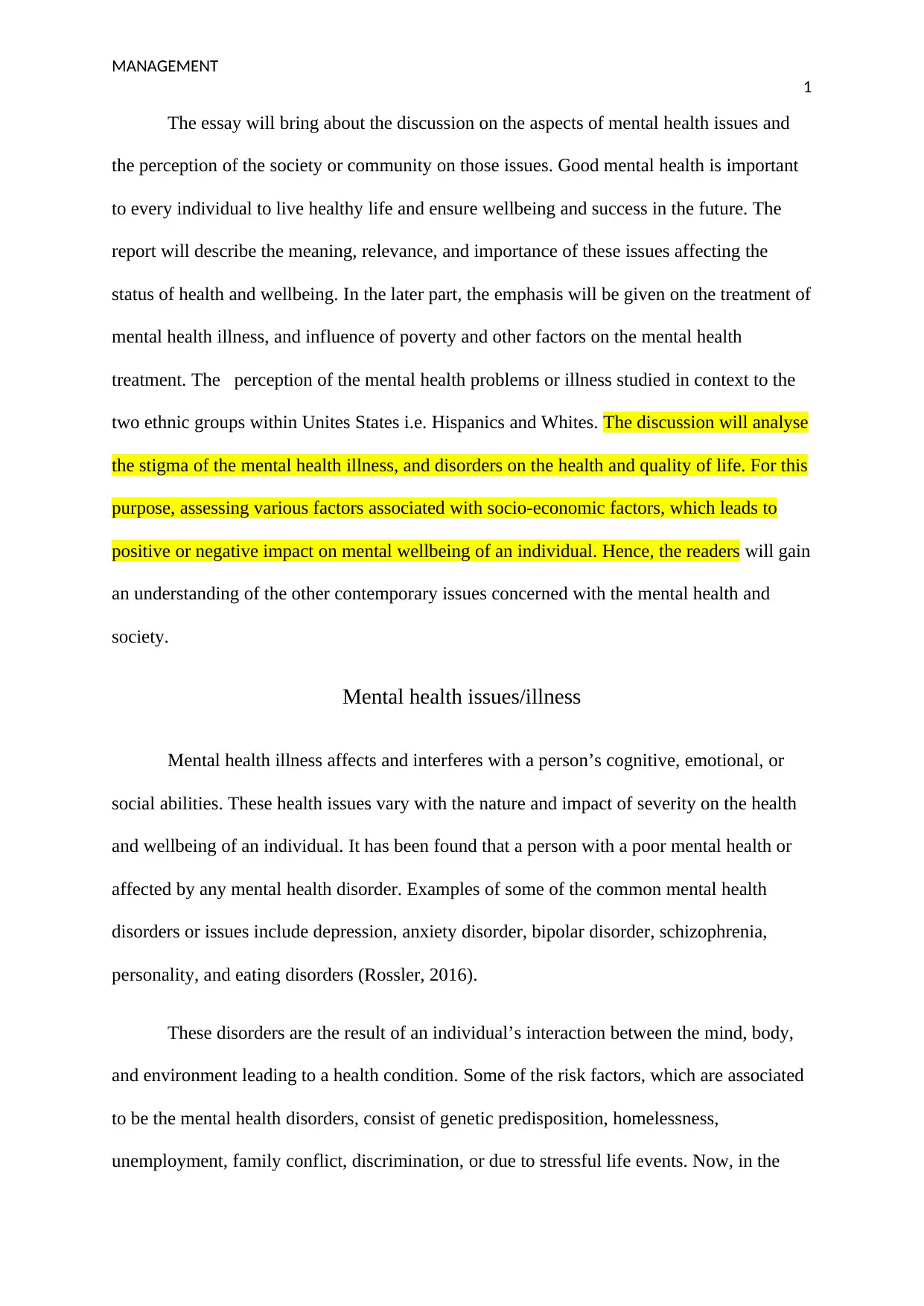
MANAGEMENT
1
The essay will bring about the discussion on the aspects of mental health issues and
the perception of the society or community on those issues. Good mental health is important
to every individual to live healthy life and ensure wellbeing and success in the future. The
report will describe the meaning, relevance, and importance of these issues affecting the
status of health and wellbeing. In the later part, the emphasis will be given on the treatment of
mental health illness, and influence of poverty and other factors on the mental health
treatment. The perception of the mental health problems or illness studied in context to the
two ethnic groups within Unites States i.e. Hispanics and Whites. The discussion will analyse
the stigma of the mental health illness, and disorders on the health and quality of life. For this
purpose, assessing various factors associated with socio-economic factors, which leads to
positive or negative impact on mental wellbeing of an individual. Hence, the readers will gain
an understanding of the other contemporary issues concerned with the mental health and
society.
Mental health issues/illness
Mental health illness affects and interferes with a person’s cognitive, emotional, or
social abilities. These health issues vary with the nature and impact of severity on the health
and wellbeing of an individual. It has been found that a person with a poor mental health or
affected by any mental health disorder. Examples of some of the common mental health
disorders or issues include depression, anxiety disorder, bipolar disorder, schizophrenia,
personality, and eating disorders (Rossler, 2016).
These disorders are the result of an individual’s interaction between the mind, body,
and environment leading to a health condition. Some of the risk factors, which are associated
to be the mental health disorders, consist of genetic predisposition, homelessness,
unemployment, family conflict, discrimination, or due to stressful life events. Now, in the
1
The essay will bring about the discussion on the aspects of mental health issues and
the perception of the society or community on those issues. Good mental health is important
to every individual to live healthy life and ensure wellbeing and success in the future. The
report will describe the meaning, relevance, and importance of these issues affecting the
status of health and wellbeing. In the later part, the emphasis will be given on the treatment of
mental health illness, and influence of poverty and other factors on the mental health
treatment. The perception of the mental health problems or illness studied in context to the
two ethnic groups within Unites States i.e. Hispanics and Whites. The discussion will analyse
the stigma of the mental health illness, and disorders on the health and quality of life. For this
purpose, assessing various factors associated with socio-economic factors, which leads to
positive or negative impact on mental wellbeing of an individual. Hence, the readers will gain
an understanding of the other contemporary issues concerned with the mental health and
society.
Mental health issues/illness
Mental health illness affects and interferes with a person’s cognitive, emotional, or
social abilities. These health issues vary with the nature and impact of severity on the health
and wellbeing of an individual. It has been found that a person with a poor mental health or
affected by any mental health disorder. Examples of some of the common mental health
disorders or issues include depression, anxiety disorder, bipolar disorder, schizophrenia,
personality, and eating disorders (Rossler, 2016).
These disorders are the result of an individual’s interaction between the mind, body,
and environment leading to a health condition. Some of the risk factors, which are associated
to be the mental health disorders, consist of genetic predisposition, homelessness,
unemployment, family conflict, discrimination, or due to stressful life events. Now, in the
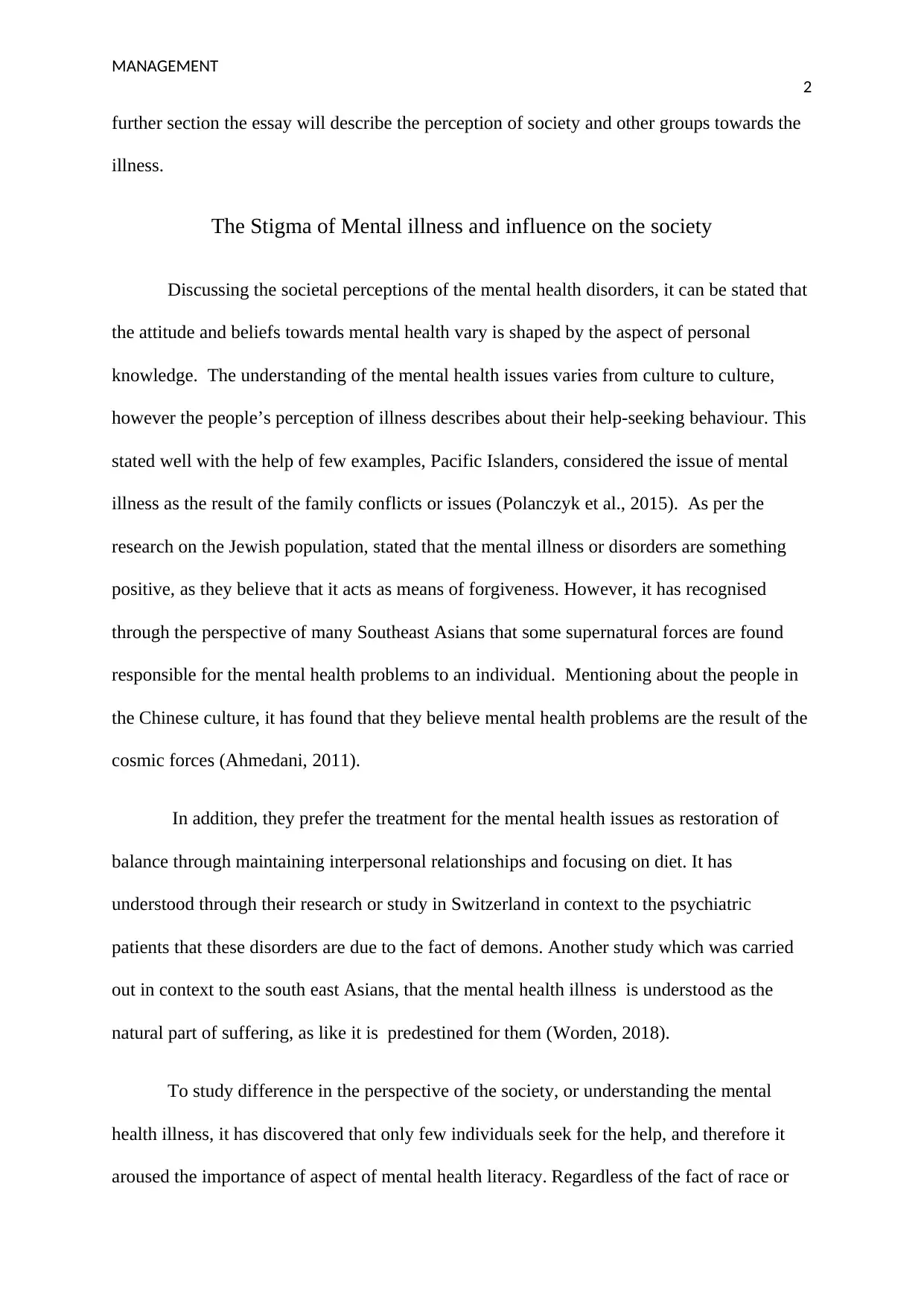
MANAGEMENT
2
further section the essay will describe the perception of society and other groups towards the
illness.
The Stigma of Mental illness and influence on the society
Discussing the societal perceptions of the mental health disorders, it can be stated that
the attitude and beliefs towards mental health vary is shaped by the aspect of personal
knowledge. The understanding of the mental health issues varies from culture to culture,
however the people’s perception of illness describes about their help-seeking behaviour. This
stated well with the help of few examples, Pacific Islanders, considered the issue of mental
illness as the result of the family conflicts or issues (Polanczyk et al., 2015). As per the
research on the Jewish population, stated that the mental illness or disorders are something
positive, as they believe that it acts as means of forgiveness. However, it has recognised
through the perspective of many Southeast Asians that some supernatural forces are found
responsible for the mental health problems to an individual. Mentioning about the people in
the Chinese culture, it has found that they believe mental health problems are the result of the
cosmic forces (Ahmedani, 2011).
In addition, they prefer the treatment for the mental health issues as restoration of
balance through maintaining interpersonal relationships and focusing on diet. It has
understood through their research or study in Switzerland in context to the psychiatric
patients that these disorders are due to the fact of demons. Another study which was carried
out in context to the south east Asians, that the mental health illness is understood as the
natural part of suffering, as like it is predestined for them (Worden, 2018).
To study difference in the perspective of the society, or understanding the mental
health illness, it has discovered that only few individuals seek for the help, and therefore it
aroused the importance of aspect of mental health literacy. Regardless of the fact of race or
2
further section the essay will describe the perception of society and other groups towards the
illness.
The Stigma of Mental illness and influence on the society
Discussing the societal perceptions of the mental health disorders, it can be stated that
the attitude and beliefs towards mental health vary is shaped by the aspect of personal
knowledge. The understanding of the mental health issues varies from culture to culture,
however the people’s perception of illness describes about their help-seeking behaviour. This
stated well with the help of few examples, Pacific Islanders, considered the issue of mental
illness as the result of the family conflicts or issues (Polanczyk et al., 2015). As per the
research on the Jewish population, stated that the mental illness or disorders are something
positive, as they believe that it acts as means of forgiveness. However, it has recognised
through the perspective of many Southeast Asians that some supernatural forces are found
responsible for the mental health problems to an individual. Mentioning about the people in
the Chinese culture, it has found that they believe mental health problems are the result of the
cosmic forces (Ahmedani, 2011).
In addition, they prefer the treatment for the mental health issues as restoration of
balance through maintaining interpersonal relationships and focusing on diet. It has
understood through their research or study in Switzerland in context to the psychiatric
patients that these disorders are due to the fact of demons. Another study which was carried
out in context to the south east Asians, that the mental health illness is understood as the
natural part of suffering, as like it is predestined for them (Worden, 2018).
To study difference in the perspective of the society, or understanding the mental
health illness, it has discovered that only few individuals seek for the help, and therefore it
aroused the importance of aspect of mental health literacy. Regardless of the fact of race or
⊘ This is a preview!⊘
Do you want full access?
Subscribe today to unlock all pages.

Trusted by 1+ million students worldwide
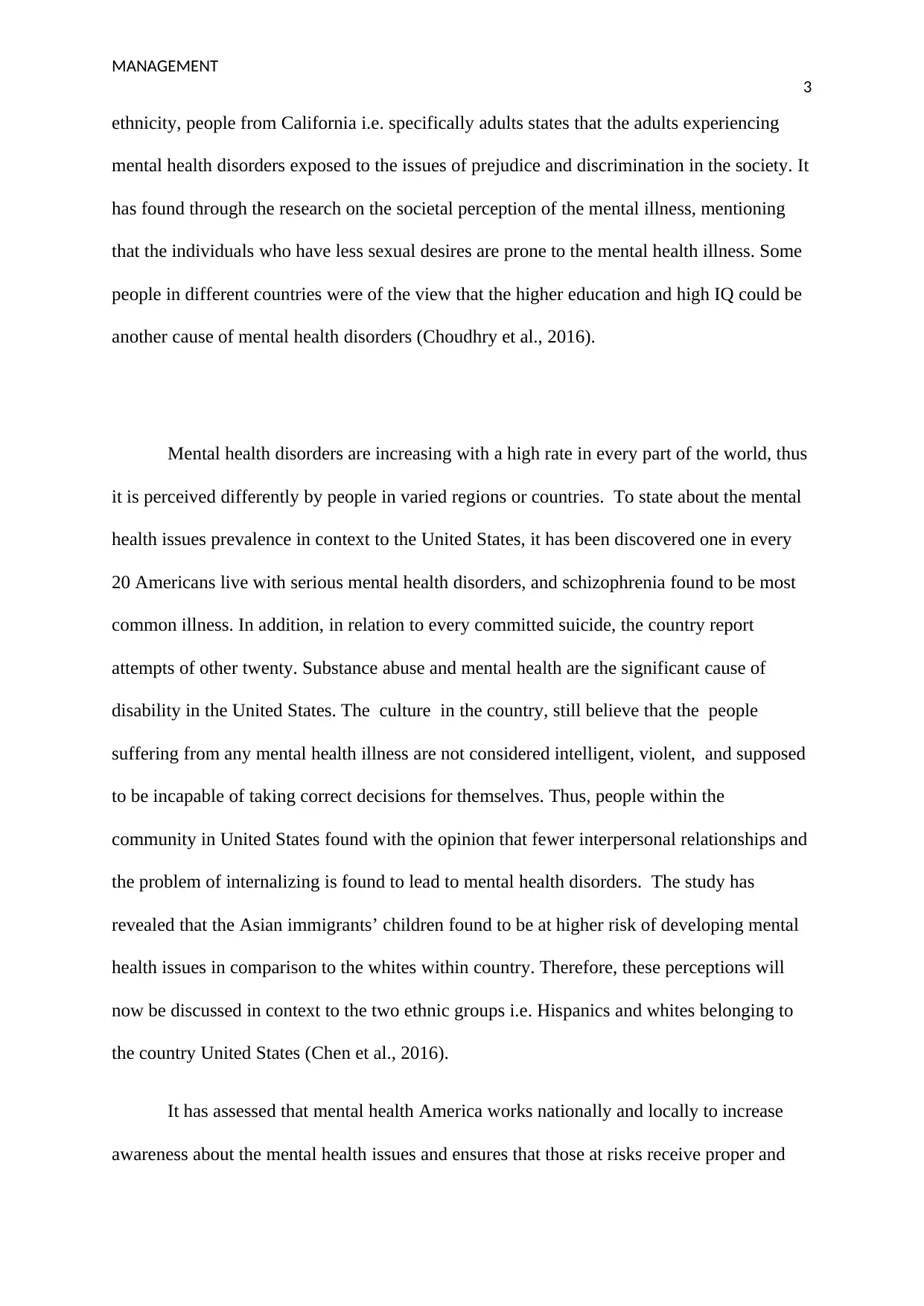
MANAGEMENT
3
ethnicity, people from California i.e. specifically adults states that the adults experiencing
mental health disorders exposed to the issues of prejudice and discrimination in the society. It
has found through the research on the societal perception of the mental illness, mentioning
that the individuals who have less sexual desires are prone to the mental health illness. Some
people in different countries were of the view that the higher education and high IQ could be
another cause of mental health disorders (Choudhry et al., 2016).
Mental health disorders are increasing with a high rate in every part of the world, thus
it is perceived differently by people in varied regions or countries. To state about the mental
health issues prevalence in context to the United States, it has been discovered one in every
20 Americans live with serious mental health disorders, and schizophrenia found to be most
common illness. In addition, in relation to every committed suicide, the country report
attempts of other twenty. Substance abuse and mental health are the significant cause of
disability in the United States. The culture in the country, still believe that the people
suffering from any mental health illness are not considered intelligent, violent, and supposed
to be incapable of taking correct decisions for themselves. Thus, people within the
community in United States found with the opinion that fewer interpersonal relationships and
the problem of internalizing is found to lead to mental health disorders. The study has
revealed that the Asian immigrants’ children found to be at higher risk of developing mental
health issues in comparison to the whites within country. Therefore, these perceptions will
now be discussed in context to the two ethnic groups i.e. Hispanics and whites belonging to
the country United States (Chen et al., 2016).
It has assessed that mental health America works nationally and locally to increase
awareness about the mental health issues and ensures that those at risks receive proper and
3
ethnicity, people from California i.e. specifically adults states that the adults experiencing
mental health disorders exposed to the issues of prejudice and discrimination in the society. It
has found through the research on the societal perception of the mental illness, mentioning
that the individuals who have less sexual desires are prone to the mental health illness. Some
people in different countries were of the view that the higher education and high IQ could be
another cause of mental health disorders (Choudhry et al., 2016).
Mental health disorders are increasing with a high rate in every part of the world, thus
it is perceived differently by people in varied regions or countries. To state about the mental
health issues prevalence in context to the United States, it has been discovered one in every
20 Americans live with serious mental health disorders, and schizophrenia found to be most
common illness. In addition, in relation to every committed suicide, the country report
attempts of other twenty. Substance abuse and mental health are the significant cause of
disability in the United States. The culture in the country, still believe that the people
suffering from any mental health illness are not considered intelligent, violent, and supposed
to be incapable of taking correct decisions for themselves. Thus, people within the
community in United States found with the opinion that fewer interpersonal relationships and
the problem of internalizing is found to lead to mental health disorders. The study has
revealed that the Asian immigrants’ children found to be at higher risk of developing mental
health issues in comparison to the whites within country. Therefore, these perceptions will
now be discussed in context to the two ethnic groups i.e. Hispanics and whites belonging to
the country United States (Chen et al., 2016).
It has assessed that mental health America works nationally and locally to increase
awareness about the mental health issues and ensures that those at risks receive proper and
Paraphrase This Document
Need a fresh take? Get an instant paraphrase of this document with our AI Paraphraser
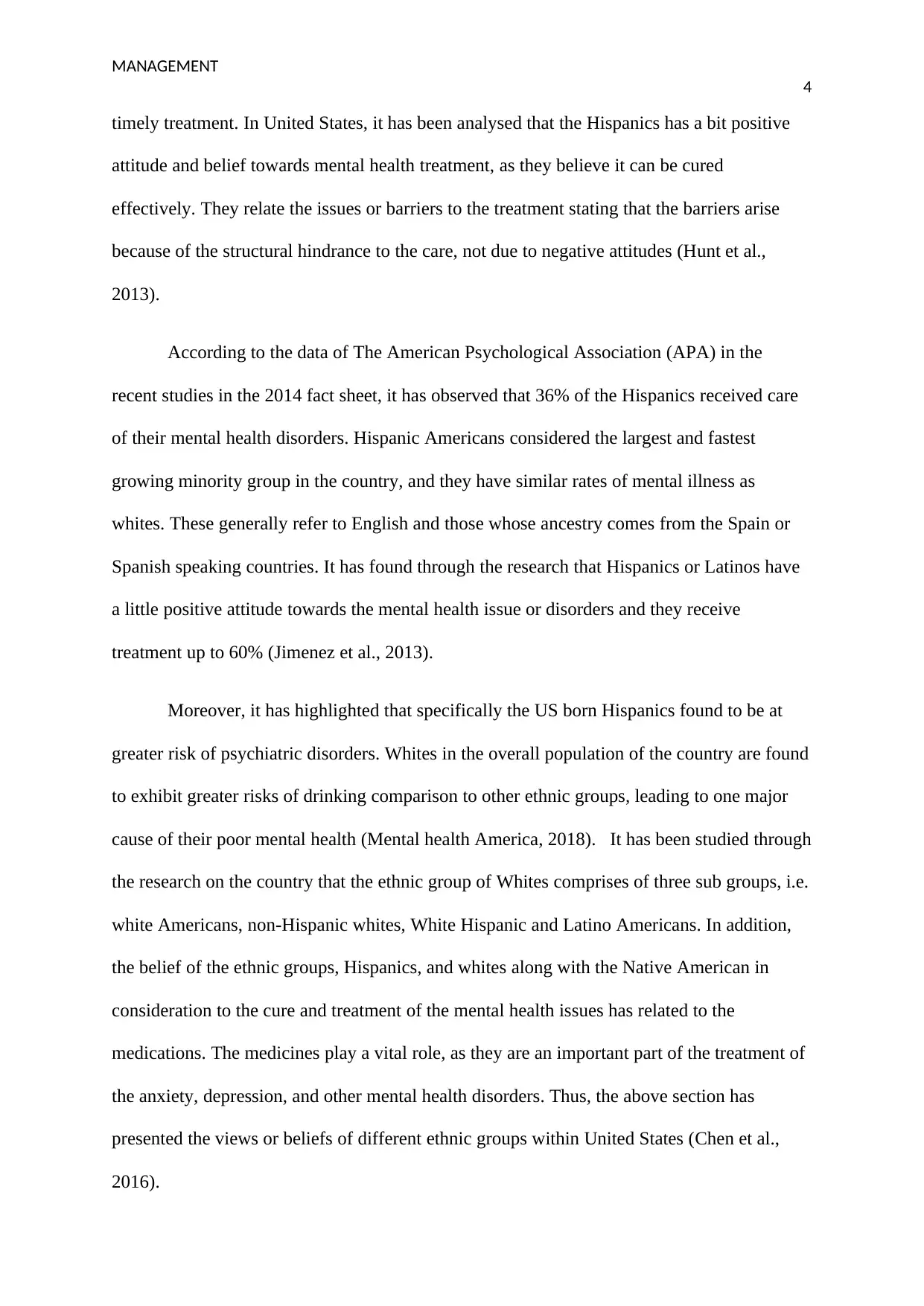
MANAGEMENT
4
timely treatment. In United States, it has been analysed that the Hispanics has a bit positive
attitude and belief towards mental health treatment, as they believe it can be cured
effectively. They relate the issues or barriers to the treatment stating that the barriers arise
because of the structural hindrance to the care, not due to negative attitudes (Hunt et al.,
2013).
According to the data of The American Psychological Association (APA) in the
recent studies in the 2014 fact sheet, it has observed that 36% of the Hispanics received care
of their mental health disorders. Hispanic Americans considered the largest and fastest
growing minority group in the country, and they have similar rates of mental illness as
whites. These generally refer to English and those whose ancestry comes from the Spain or
Spanish speaking countries. It has found through the research that Hispanics or Latinos have
a little positive attitude towards the mental health issue or disorders and they receive
treatment up to 60% (Jimenez et al., 2013).
Moreover, it has highlighted that specifically the US born Hispanics found to be at
greater risk of psychiatric disorders. Whites in the overall population of the country are found
to exhibit greater risks of drinking comparison to other ethnic groups, leading to one major
cause of their poor mental health (Mental health America, 2018). It has been studied through
the research on the country that the ethnic group of Whites comprises of three sub groups, i.e.
white Americans, non-Hispanic whites, White Hispanic and Latino Americans. In addition,
the belief of the ethnic groups, Hispanics, and whites along with the Native American in
consideration to the cure and treatment of the mental health issues has related to the
medications. The medicines play a vital role, as they are an important part of the treatment of
the anxiety, depression, and other mental health disorders. Thus, the above section has
presented the views or beliefs of different ethnic groups within United States (Chen et al.,
2016).
4
timely treatment. In United States, it has been analysed that the Hispanics has a bit positive
attitude and belief towards mental health treatment, as they believe it can be cured
effectively. They relate the issues or barriers to the treatment stating that the barriers arise
because of the structural hindrance to the care, not due to negative attitudes (Hunt et al.,
2013).
According to the data of The American Psychological Association (APA) in the
recent studies in the 2014 fact sheet, it has observed that 36% of the Hispanics received care
of their mental health disorders. Hispanic Americans considered the largest and fastest
growing minority group in the country, and they have similar rates of mental illness as
whites. These generally refer to English and those whose ancestry comes from the Spain or
Spanish speaking countries. It has found through the research that Hispanics or Latinos have
a little positive attitude towards the mental health issue or disorders and they receive
treatment up to 60% (Jimenez et al., 2013).
Moreover, it has highlighted that specifically the US born Hispanics found to be at
greater risk of psychiatric disorders. Whites in the overall population of the country are found
to exhibit greater risks of drinking comparison to other ethnic groups, leading to one major
cause of their poor mental health (Mental health America, 2018). It has been studied through
the research on the country that the ethnic group of Whites comprises of three sub groups, i.e.
white Americans, non-Hispanic whites, White Hispanic and Latino Americans. In addition,
the belief of the ethnic groups, Hispanics, and whites along with the Native American in
consideration to the cure and treatment of the mental health issues has related to the
medications. The medicines play a vital role, as they are an important part of the treatment of
the anxiety, depression, and other mental health disorders. Thus, the above section has
presented the views or beliefs of different ethnic groups within United States (Chen et al.,
2016).
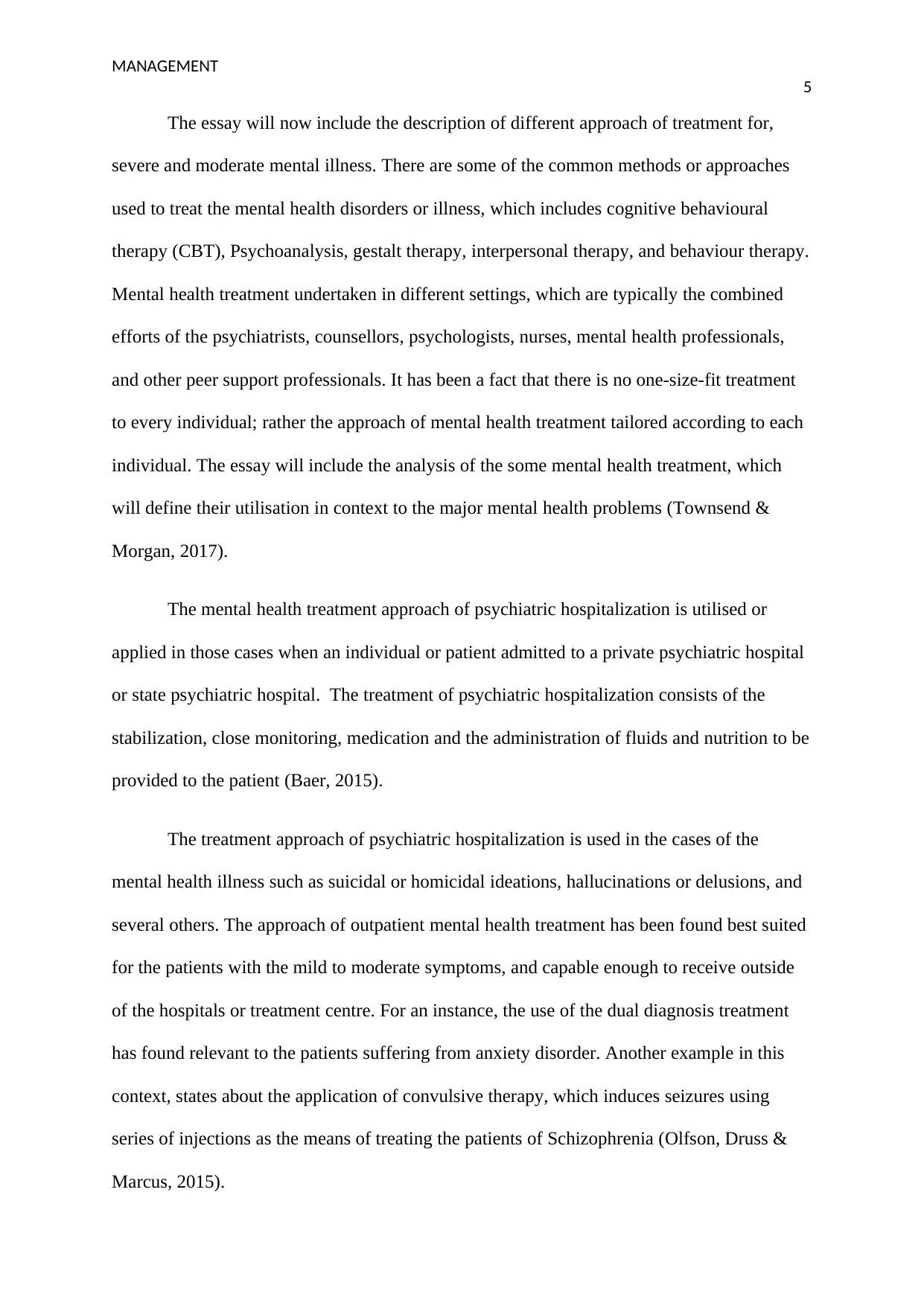
MANAGEMENT
5
The essay will now include the description of different approach of treatment for,
severe and moderate mental illness. There are some of the common methods or approaches
used to treat the mental health disorders or illness, which includes cognitive behavioural
therapy (CBT), Psychoanalysis, gestalt therapy, interpersonal therapy, and behaviour therapy.
Mental health treatment undertaken in different settings, which are typically the combined
efforts of the psychiatrists, counsellors, psychologists, nurses, mental health professionals,
and other peer support professionals. It has been a fact that there is no one-size-fit treatment
to every individual; rather the approach of mental health treatment tailored according to each
individual. The essay will include the analysis of the some mental health treatment, which
will define their utilisation in context to the major mental health problems (Townsend &
Morgan, 2017).
The mental health treatment approach of psychiatric hospitalization is utilised or
applied in those cases when an individual or patient admitted to a private psychiatric hospital
or state psychiatric hospital. The treatment of psychiatric hospitalization consists of the
stabilization, close monitoring, medication and the administration of fluids and nutrition to be
provided to the patient (Baer, 2015).
The treatment approach of psychiatric hospitalization is used in the cases of the
mental health illness such as suicidal or homicidal ideations, hallucinations or delusions, and
several others. The approach of outpatient mental health treatment has been found best suited
for the patients with the mild to moderate symptoms, and capable enough to receive outside
of the hospitals or treatment centre. For an instance, the use of the dual diagnosis treatment
has found relevant to the patients suffering from anxiety disorder. Another example in this
context, states about the application of convulsive therapy, which induces seizures using
series of injections as the means of treating the patients of Schizophrenia (Olfson, Druss &
Marcus, 2015).
5
The essay will now include the description of different approach of treatment for,
severe and moderate mental illness. There are some of the common methods or approaches
used to treat the mental health disorders or illness, which includes cognitive behavioural
therapy (CBT), Psychoanalysis, gestalt therapy, interpersonal therapy, and behaviour therapy.
Mental health treatment undertaken in different settings, which are typically the combined
efforts of the psychiatrists, counsellors, psychologists, nurses, mental health professionals,
and other peer support professionals. It has been a fact that there is no one-size-fit treatment
to every individual; rather the approach of mental health treatment tailored according to each
individual. The essay will include the analysis of the some mental health treatment, which
will define their utilisation in context to the major mental health problems (Townsend &
Morgan, 2017).
The mental health treatment approach of psychiatric hospitalization is utilised or
applied in those cases when an individual or patient admitted to a private psychiatric hospital
or state psychiatric hospital. The treatment of psychiatric hospitalization consists of the
stabilization, close monitoring, medication and the administration of fluids and nutrition to be
provided to the patient (Baer, 2015).
The treatment approach of psychiatric hospitalization is used in the cases of the
mental health illness such as suicidal or homicidal ideations, hallucinations or delusions, and
several others. The approach of outpatient mental health treatment has been found best suited
for the patients with the mild to moderate symptoms, and capable enough to receive outside
of the hospitals or treatment centre. For an instance, the use of the dual diagnosis treatment
has found relevant to the patients suffering from anxiety disorder. Another example in this
context, states about the application of convulsive therapy, which induces seizures using
series of injections as the means of treating the patients of Schizophrenia (Olfson, Druss &
Marcus, 2015).
⊘ This is a preview!⊘
Do you want full access?
Subscribe today to unlock all pages.

Trusted by 1+ million students worldwide
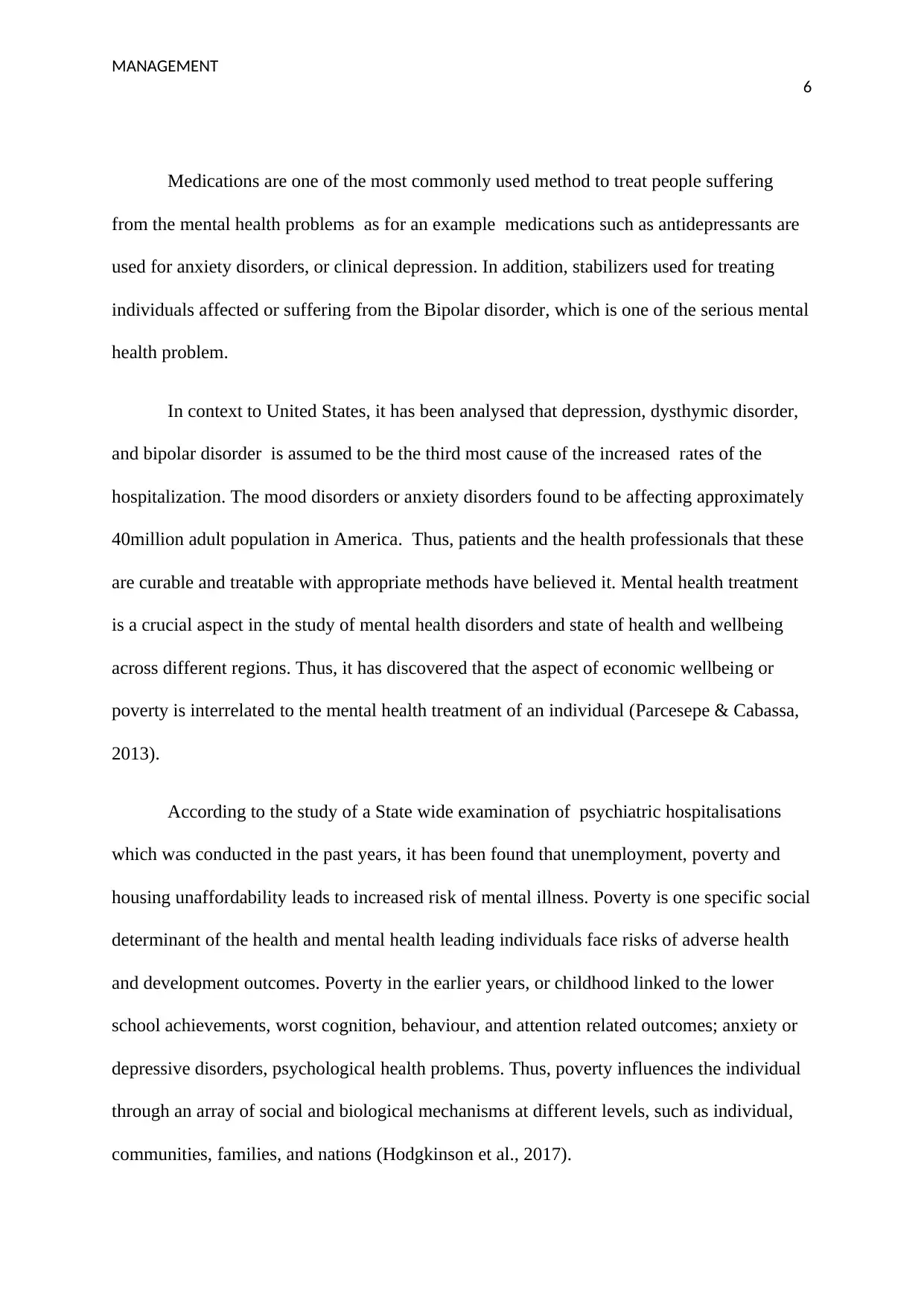
MANAGEMENT
6
Medications are one of the most commonly used method to treat people suffering
from the mental health problems as for an example medications such as antidepressants are
used for anxiety disorders, or clinical depression. In addition, stabilizers used for treating
individuals affected or suffering from the Bipolar disorder, which is one of the serious mental
health problem.
In context to United States, it has been analysed that depression, dysthymic disorder,
and bipolar disorder is assumed to be the third most cause of the increased rates of the
hospitalization. The mood disorders or anxiety disorders found to be affecting approximately
40million adult population in America. Thus, patients and the health professionals that these
are curable and treatable with appropriate methods have believed it. Mental health treatment
is a crucial aspect in the study of mental health disorders and state of health and wellbeing
across different regions. Thus, it has discovered that the aspect of economic wellbeing or
poverty is interrelated to the mental health treatment of an individual (Parcesepe & Cabassa,
2013).
According to the study of a State wide examination of psychiatric hospitalisations
which was conducted in the past years, it has been found that unemployment, poverty and
housing unaffordability leads to increased risk of mental illness. Poverty is one specific social
determinant of the health and mental health leading individuals face risks of adverse health
and development outcomes. Poverty in the earlier years, or childhood linked to the lower
school achievements, worst cognition, behaviour, and attention related outcomes; anxiety or
depressive disorders, psychological health problems. Thus, poverty influences the individual
through an array of social and biological mechanisms at different levels, such as individual,
communities, families, and nations (Hodgkinson et al., 2017).
6
Medications are one of the most commonly used method to treat people suffering
from the mental health problems as for an example medications such as antidepressants are
used for anxiety disorders, or clinical depression. In addition, stabilizers used for treating
individuals affected or suffering from the Bipolar disorder, which is one of the serious mental
health problem.
In context to United States, it has been analysed that depression, dysthymic disorder,
and bipolar disorder is assumed to be the third most cause of the increased rates of the
hospitalization. The mood disorders or anxiety disorders found to be affecting approximately
40million adult population in America. Thus, patients and the health professionals that these
are curable and treatable with appropriate methods have believed it. Mental health treatment
is a crucial aspect in the study of mental health disorders and state of health and wellbeing
across different regions. Thus, it has discovered that the aspect of economic wellbeing or
poverty is interrelated to the mental health treatment of an individual (Parcesepe & Cabassa,
2013).
According to the study of a State wide examination of psychiatric hospitalisations
which was conducted in the past years, it has been found that unemployment, poverty and
housing unaffordability leads to increased risk of mental illness. Poverty is one specific social
determinant of the health and mental health leading individuals face risks of adverse health
and development outcomes. Poverty in the earlier years, or childhood linked to the lower
school achievements, worst cognition, behaviour, and attention related outcomes; anxiety or
depressive disorders, psychological health problems. Thus, poverty influences the individual
through an array of social and biological mechanisms at different levels, such as individual,
communities, families, and nations (Hodgkinson et al., 2017).
Paraphrase This Document
Need a fresh take? Get an instant paraphrase of this document with our AI Paraphraser
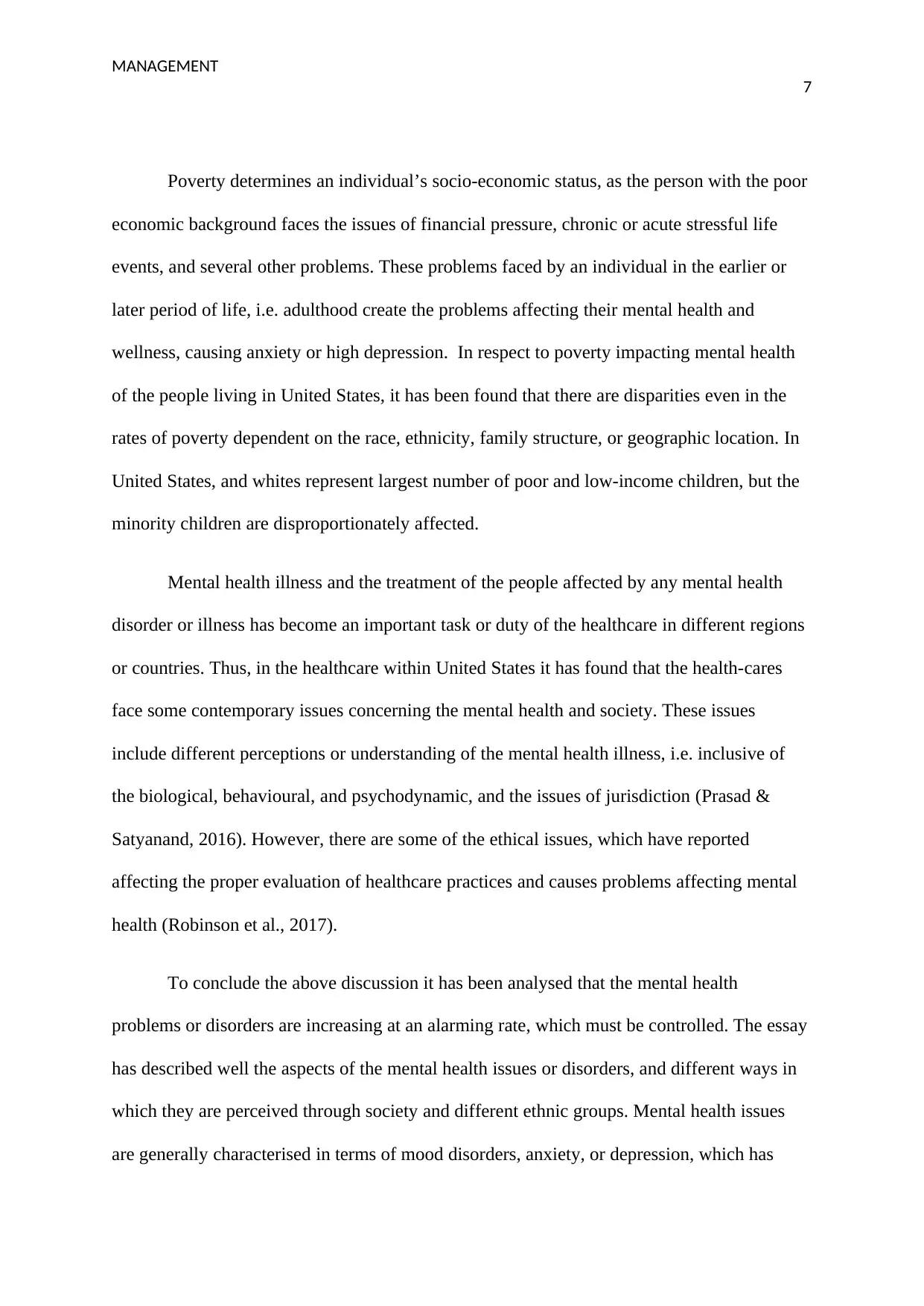
MANAGEMENT
7
Poverty determines an individual’s socio-economic status, as the person with the poor
economic background faces the issues of financial pressure, chronic or acute stressful life
events, and several other problems. These problems faced by an individual in the earlier or
later period of life, i.e. adulthood create the problems affecting their mental health and
wellness, causing anxiety or high depression. In respect to poverty impacting mental health
of the people living in United States, it has been found that there are disparities even in the
rates of poverty dependent on the race, ethnicity, family structure, or geographic location. In
United States, and whites represent largest number of poor and low-income children, but the
minority children are disproportionately affected.
Mental health illness and the treatment of the people affected by any mental health
disorder or illness has become an important task or duty of the healthcare in different regions
or countries. Thus, in the healthcare within United States it has found that the health-cares
face some contemporary issues concerning the mental health and society. These issues
include different perceptions or understanding of the mental health illness, i.e. inclusive of
the biological, behavioural, and psychodynamic, and the issues of jurisdiction (Prasad &
Satyanand, 2016). However, there are some of the ethical issues, which have reported
affecting the proper evaluation of healthcare practices and causes problems affecting mental
health (Robinson et al., 2017).
To conclude the above discussion it has been analysed that the mental health
problems or disorders are increasing at an alarming rate, which must be controlled. The essay
has described well the aspects of the mental health issues or disorders, and different ways in
which they are perceived through society and different ethnic groups. Mental health issues
are generally characterised in terms of mood disorders, anxiety, or depression, which has
7
Poverty determines an individual’s socio-economic status, as the person with the poor
economic background faces the issues of financial pressure, chronic or acute stressful life
events, and several other problems. These problems faced by an individual in the earlier or
later period of life, i.e. adulthood create the problems affecting their mental health and
wellness, causing anxiety or high depression. In respect to poverty impacting mental health
of the people living in United States, it has been found that there are disparities even in the
rates of poverty dependent on the race, ethnicity, family structure, or geographic location. In
United States, and whites represent largest number of poor and low-income children, but the
minority children are disproportionately affected.
Mental health illness and the treatment of the people affected by any mental health
disorder or illness has become an important task or duty of the healthcare in different regions
or countries. Thus, in the healthcare within United States it has found that the health-cares
face some contemporary issues concerning the mental health and society. These issues
include different perceptions or understanding of the mental health illness, i.e. inclusive of
the biological, behavioural, and psychodynamic, and the issues of jurisdiction (Prasad &
Satyanand, 2016). However, there are some of the ethical issues, which have reported
affecting the proper evaluation of healthcare practices and causes problems affecting mental
health (Robinson et al., 2017).
To conclude the above discussion it has been analysed that the mental health
problems or disorders are increasing at an alarming rate, which must be controlled. The essay
has described well the aspects of the mental health issues or disorders, and different ways in
which they are perceived through society and different ethnic groups. Mental health issues
are generally characterised in terms of mood disorders, anxiety, or depression, which has

MANAGEMENT
8
found common in the individuals in United States. Thus, people or health professionals must
emphasize on the early diagnosis and treatment of the people suffering from any mental
health diseases.
8
found common in the individuals in United States. Thus, people or health professionals must
emphasize on the early diagnosis and treatment of the people suffering from any mental
health diseases.
⊘ This is a preview!⊘
Do you want full access?
Subscribe today to unlock all pages.

Trusted by 1+ million students worldwide
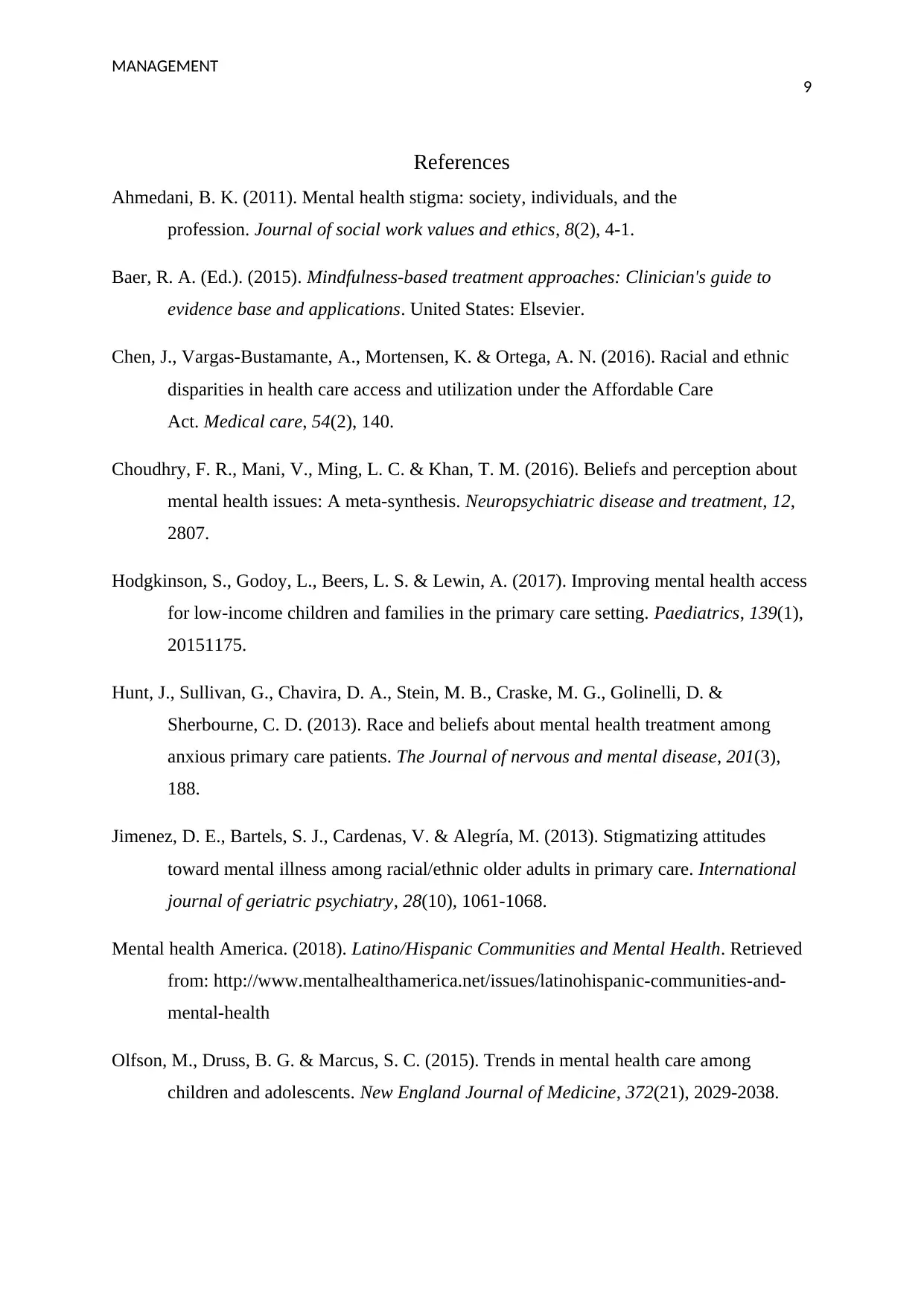
MANAGEMENT
9
References
Ahmedani, B. K. (2011). Mental health stigma: society, individuals, and the
profession. Journal of social work values and ethics, 8(2), 4-1.
Baer, R. A. (Ed.). (2015). Mindfulness-based treatment approaches: Clinician's guide to
evidence base and applications. United States: Elsevier.
Chen, J., Vargas-Bustamante, A., Mortensen, K. & Ortega, A. N. (2016). Racial and ethnic
disparities in health care access and utilization under the Affordable Care
Act. Medical care, 54(2), 140.
Choudhry, F. R., Mani, V., Ming, L. C. & Khan, T. M. (2016). Beliefs and perception about
mental health issues: A meta-synthesis. Neuropsychiatric disease and treatment, 12,
2807.
Hodgkinson, S., Godoy, L., Beers, L. S. & Lewin, A. (2017). Improving mental health access
for low-income children and families in the primary care setting. Paediatrics, 139(1),
20151175.
Hunt, J., Sullivan, G., Chavira, D. A., Stein, M. B., Craske, M. G., Golinelli, D. &
Sherbourne, C. D. (2013). Race and beliefs about mental health treatment among
anxious primary care patients. The Journal of nervous and mental disease, 201(3),
188.
Jimenez, D. E., Bartels, S. J., Cardenas, V. & Alegría, M. (2013). Stigmatizing attitudes
toward mental illness among racial/ethnic older adults in primary care. International
journal of geriatric psychiatry, 28(10), 1061-1068.
Mental health America. (2018). Latino/Hispanic Communities and Mental Health. Retrieved
from: http://www.mentalhealthamerica.net/issues/latinohispanic-communities-and-
mental-health
Olfson, M., Druss, B. G. & Marcus, S. C. (2015). Trends in mental health care among
children and adolescents. New England Journal of Medicine, 372(21), 2029-2038.
9
References
Ahmedani, B. K. (2011). Mental health stigma: society, individuals, and the
profession. Journal of social work values and ethics, 8(2), 4-1.
Baer, R. A. (Ed.). (2015). Mindfulness-based treatment approaches: Clinician's guide to
evidence base and applications. United States: Elsevier.
Chen, J., Vargas-Bustamante, A., Mortensen, K. & Ortega, A. N. (2016). Racial and ethnic
disparities in health care access and utilization under the Affordable Care
Act. Medical care, 54(2), 140.
Choudhry, F. R., Mani, V., Ming, L. C. & Khan, T. M. (2016). Beliefs and perception about
mental health issues: A meta-synthesis. Neuropsychiatric disease and treatment, 12,
2807.
Hodgkinson, S., Godoy, L., Beers, L. S. & Lewin, A. (2017). Improving mental health access
for low-income children and families in the primary care setting. Paediatrics, 139(1),
20151175.
Hunt, J., Sullivan, G., Chavira, D. A., Stein, M. B., Craske, M. G., Golinelli, D. &
Sherbourne, C. D. (2013). Race and beliefs about mental health treatment among
anxious primary care patients. The Journal of nervous and mental disease, 201(3),
188.
Jimenez, D. E., Bartels, S. J., Cardenas, V. & Alegría, M. (2013). Stigmatizing attitudes
toward mental illness among racial/ethnic older adults in primary care. International
journal of geriatric psychiatry, 28(10), 1061-1068.
Mental health America. (2018). Latino/Hispanic Communities and Mental Health. Retrieved
from: http://www.mentalhealthamerica.net/issues/latinohispanic-communities-and-
mental-health
Olfson, M., Druss, B. G. & Marcus, S. C. (2015). Trends in mental health care among
children and adolescents. New England Journal of Medicine, 372(21), 2029-2038.
Paraphrase This Document
Need a fresh take? Get an instant paraphrase of this document with our AI Paraphraser
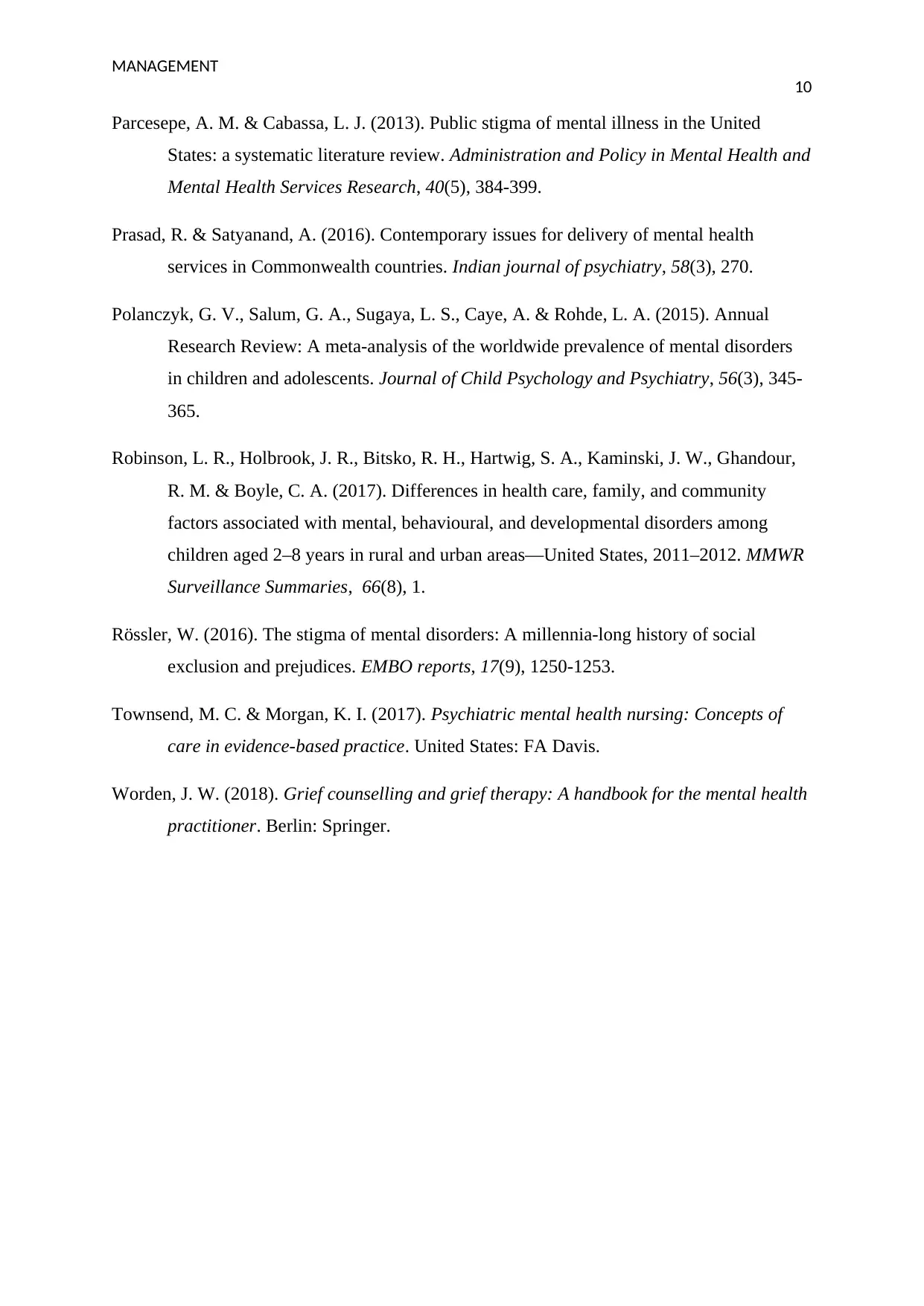
MANAGEMENT
10
Parcesepe, A. M. & Cabassa, L. J. (2013). Public stigma of mental illness in the United
States: a systematic literature review. Administration and Policy in Mental Health and
Mental Health Services Research, 40(5), 384-399.
Prasad, R. & Satyanand, A. (2016). Contemporary issues for delivery of mental health
services in Commonwealth countries. Indian journal of psychiatry, 58(3), 270.
Polanczyk, G. V., Salum, G. A., Sugaya, L. S., Caye, A. & Rohde, L. A. (2015). Annual
Research Review: A meta‐analysis of the worldwide prevalence of mental disorders
in children and adolescents. Journal of Child Psychology and Psychiatry, 56(3), 345-
365.
Robinson, L. R., Holbrook, J. R., Bitsko, R. H., Hartwig, S. A., Kaminski, J. W., Ghandour,
R. M. & Boyle, C. A. (2017). Differences in health care, family, and community
factors associated with mental, behavioural, and developmental disorders among
children aged 2–8 years in rural and urban areas—United States, 2011–2012. MMWR
Surveillance Summaries, 66(8), 1.
Rössler, W. (2016). The stigma of mental disorders: A millennia‐long history of social
exclusion and prejudices. EMBO reports, 17(9), 1250-1253.
Townsend, M. C. & Morgan, K. I. (2017). Psychiatric mental health nursing: Concepts of
care in evidence-based practice. United States: FA Davis.
Worden, J. W. (2018). Grief counselling and grief therapy: A handbook for the mental health
practitioner. Berlin: Springer.
10
Parcesepe, A. M. & Cabassa, L. J. (2013). Public stigma of mental illness in the United
States: a systematic literature review. Administration and Policy in Mental Health and
Mental Health Services Research, 40(5), 384-399.
Prasad, R. & Satyanand, A. (2016). Contemporary issues for delivery of mental health
services in Commonwealth countries. Indian journal of psychiatry, 58(3), 270.
Polanczyk, G. V., Salum, G. A., Sugaya, L. S., Caye, A. & Rohde, L. A. (2015). Annual
Research Review: A meta‐analysis of the worldwide prevalence of mental disorders
in children and adolescents. Journal of Child Psychology and Psychiatry, 56(3), 345-
365.
Robinson, L. R., Holbrook, J. R., Bitsko, R. H., Hartwig, S. A., Kaminski, J. W., Ghandour,
R. M. & Boyle, C. A. (2017). Differences in health care, family, and community
factors associated with mental, behavioural, and developmental disorders among
children aged 2–8 years in rural and urban areas—United States, 2011–2012. MMWR
Surveillance Summaries, 66(8), 1.
Rössler, W. (2016). The stigma of mental disorders: A millennia‐long history of social
exclusion and prejudices. EMBO reports, 17(9), 1250-1253.
Townsend, M. C. & Morgan, K. I. (2017). Psychiatric mental health nursing: Concepts of
care in evidence-based practice. United States: FA Davis.
Worden, J. W. (2018). Grief counselling and grief therapy: A handbook for the mental health
practitioner. Berlin: Springer.
1 out of 11
Related Documents
Your All-in-One AI-Powered Toolkit for Academic Success.
+13062052269
info@desklib.com
Available 24*7 on WhatsApp / Email
![[object Object]](/_next/static/media/star-bottom.7253800d.svg)
Unlock your academic potential
Copyright © 2020–2025 A2Z Services. All Rights Reserved. Developed and managed by ZUCOL.




